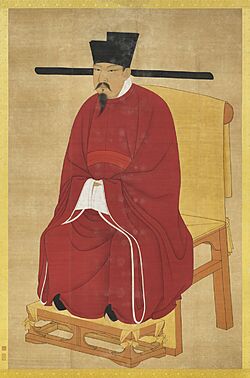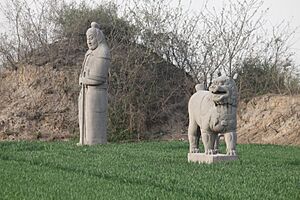Emperor Shenzong of Song facts for kids
Quick facts for kids Emperor Shenzong of Song宋神宗 |
|||||||||||||
|---|---|---|---|---|---|---|---|---|---|---|---|---|---|

|
|||||||||||||
| Emperor of the Song dynasty | |||||||||||||
| Reign | 25 January 1067 – 1 April 1085 | ||||||||||||
| Coronation | 25 January 1067 | ||||||||||||
| Predecessor | Emperor Yingzong | ||||||||||||
| Successor | Emperor Zhezong | ||||||||||||
| Born | Zhao Zhongzhen (1048–1067) Zhao Xu (1067–1085) 25 May 1048 |
||||||||||||
| Died | 1 April 1085 (aged 36) | ||||||||||||
| Burial | Yongyu Mausoleum (永裕陵, in present-day Gongyi, Henan) | ||||||||||||
| Consorts |
Empress Qincheng
(m. 1068–1085)Empress Qinci
(before 1085) |
||||||||||||
| Issue | Emperor Zhezong Zhao Bi Emperor Huizong Zhao Yu Zhao Shi Zhao Cai Princess Xianmu Princess Xianxiao Princess Xianjing |
||||||||||||
|
|||||||||||||
| House | Zhao | ||||||||||||
| Dynasty | Song (Northern Song) | ||||||||||||
| Father | Emperor Yingzong | ||||||||||||
| Mother | Empress Xuanren | ||||||||||||
| Emperor Shenzong of Song | |||||||
|---|---|---|---|---|---|---|---|
| Chinese | 宋神宗 | ||||||
| Literal meaning | "Spiritual Ancestor of the Song" | ||||||
|
|||||||
| Zhao Xu | |||||||
| Traditional Chinese | 趙頊 | ||||||
| Simplified Chinese | 赵顼 | ||||||
|
|||||||
| Zhao Zhongzhen | |||||||
| Traditional Chinese | 趙仲鍼 | ||||||
| Simplified Chinese | 赵仲针 | ||||||
|
|||||||
Emperor Shenzong of Song (born Zhao Xu) was the sixth emperor of the Song dynasty in China. He was born on May 25, 1048, and ruled from 1067 until his death on April 1, 1085. Emperor Shenzong is most famous for supporting the "New Policies" of his chief minister, Wang Anshi. These policies aimed to fix problems with the Song dynasty's money, government, and army.
Contents
Shenzong's Reign as Emperor
Shenzong's Goals
Emperor Shenzong wanted to make the Song Dynasty stronger and more respected. He disagreed with earlier emperors who preferred a peaceful approach. He believed that to expand the empire's borders, the government needed a lot of money.
He also wanted to reduce the power of some important ministers, like the chief councilor. However, some officials, like Sima Guang, worried that Shenzong was becoming too powerful. They wanted to keep peace with neighboring states like the Western Xia and the Liao Dynasty.
Muslim Soldiers in the Song Army
In 1070, Emperor Shenzong invited about 5,300 Muslim warriors from Bukhara to China. He hired them as soldiers to help fight against the Khitan Liao dynasty in the northeast. These soldiers were also meant to help repopulate areas that had been damaged by fighting.
Later, in 1080, another 10,000 Muslims were invited to China. They settled in northern and northeastern regions.
Wang Anshi's New Policies
In 1068, Emperor Shenzong became very interested in the ideas of Wang Anshi. He then made Wang Anshi his Chancellor, a very important government position. Wang Anshi then started his famous "New Policies."
These policies were designed to help farmers and people who didn't have jobs. They became the most important reforms during Emperor Shenzong's time as ruler. Before Shenzong became emperor, the Song dynasty was facing economic problems.
The government also spent a lot of money on defense (83% of its cash income) and on its large number of officials. In 1069, Shenzong fully supported Wang Anshi and his New Policies to fix these issues.
Emperor's Role in Reforms
Emperor Shenzong usually let Wang Anshi lead the reforms until Wang retired in 1076. However, Shenzong still had his own ideas. For example, he suggested bringing back the equal-field system, which was a way of sharing land. But Wang Anshi thought it wouldn't work.
Shenzong was also very interested in how charging interest could make money for the government. He invested a lot in a new policy to control prices, even though merchants complained.
Military Improvements
Shenzong and Wang Anshi also worked on improving the military. They reduced the number of soldiers in the army to less than 900,000. They also created the Area Generalship System to make the army more organized and efficient.
The Baojia system was also started. This system trained villagers to defend their homes and support the main army. However, these military reforms did not fully succeed. The Song army still struggled against the Western Xia.
Yuanfeng Reforms
In 1074, a bad drought hit northern China. Many officials thought this was a sign that the New Policies were wrong. Because of this, and other issues, Shenzong removed Wang Anshi from his top position.
However, Shenzong still believed in reforms. He later took personal control of the reform plans and started the "Yuanfeng Reforms" in 1076. He made his own power stronger and reorganized the government. He brought back a system similar to the older Tang dynasty government, with different departments balancing each other.
These reforms aimed to improve how the government managed money. They also tried to raise funds for fighting the Western Xia.
Campaigns Against Neighbors
Emperor Shenzong sent armies to fight against the Vietnamese ruler Lý Nhân Tông in 1076.
He also tried to weaken the Tangut-led Western Xia state. The Song army had some early successes. But in 1082, during a battle for the city of Yongle, the Song forces were badly defeated. This loss made the Western Xia stronger and continued to cause problems for the Song Empire.
Important Books and Writings
During Shenzong's reign, a famous historian named Sima Guang finished his huge history book, Zizhi Tongjian. This book, published in 1084, covers 1,000 years of Chinese history. Another important collection of military writings, the Seven Military Classics, was also put together during his time.
Death and Legacy
The big defeat at Yongle City in 1082 deeply saddened Emperor Shenzong. He felt that his reforms, which he had worked so hard on, had failed. After this, he started to favor the officials who had opposed his reforms, especially Sima Guang.
Emperor Shenzong died in early 1085 at the age of 36 from an illness. His son, Emperor Zhezong, became the next emperor. However, Zhezong was too young to rule, so Shenzong's mother, Empress Gao, ruled as a regent (a temporary ruler) until her death. After Shenzong's death, there was a political struggle. The conservative group, led by Empress Gao and Sima Guang, ended up winning. They canceled the New Policies and removed the reformers from the court.
Family
Consorts and Issue:
- Empress Qinsheng, of the Xiang clan (欽聖皇后 向氏; 1046–1101)
- Princess Shuhuai (淑懷帝姬; 1067–1078), 1st daughter
- Empress Qincheng, of the Zhu clan (欽成皇后 朱氏; 1052–1102)
- Zhao Xu, Zhezong (哲宗 趙煦; 1077–1100), 6th son
- Zhao Shi, Prince Churongxian (楚榮憲王 趙似; 1083–1106), 13th son
- Princess Xianjing (賢靜帝姬; 1085–1115), 10th daughter
- Married Pan Yi (潘意) in 1104, and had issue (two sons)
- Empress Qinci, of the Chen clan (欽慈皇后 陳氏; 1058–1089)
- Zhao Ji, Huizong (徽宗 趙佶; 1082–1135), 11th son
- Noble Consort Yimu, of the Xing clan (懿穆貴妃 邢氏; d. 1103)
- Zhao Jin, Prince Hui (惠王 趙僅; 1071), 2nd son
- Zhao Xian, Prince Ji (冀王 趙僩; 1074–1076), 5th son
- Zhao Jia, Prince Yudaohui (豫悼惠王 趙價; 1077–1078), 7th son
- Zhao Ti, Prince Xuchonghui (徐沖惠王 趙倜; 1078–1081), 8th son
- Noble Consort, of the Yang clan (懿靜貴妃 楊氏)
- Noble Consort, of the Song clan (貴妃 宋氏; d. 1117)
- Zhao Yi, Prince Cheng (成王 趙佾; 1069), 1st son
- Zhao Jun, Prince Tang'aixian (唐哀獻王 趙俊; 1073–1077), 3rd son
- Princess Xianxiao (賢孝帝姬; d. 1108), 4th daughter
- Married Wang Yu (王遇) in 1097
- Pure Consort, of the Zhang clan (懿靜淑妃 張氏; d. 1105)
- Princess Xianke (賢恪帝姬; d. 1072), 2nd daughter
- Virtuous Consort, of the Zhu clan (德妃 朱氏)
- Princess Xianmu (賢穆帝姬; d. 1084)
- Able Consort, of the Wu clan (惠穆賢妃 武氏; d. 1107)
- Zhao Bi, Prince Wurongmu (吳榮穆王 趙佖; 1082–1106), 9th son
- Princess Xianhe (賢和帝姬; d. 1090)
- Able Consort, of the Lin clan (賢妃 林氏; 1052–1090), personal name Zhen (貞)
- Zhao Yu, Prince Yan (燕王 趙俁; 1083–1127), 12th son
- Princess Xianling (賢令帝姬; d. 1084), 7th daughter
- Zhao Cai, Prince Yue (越王 趙偲; 1085–1129), 14th son
- Cairen, of the Guo clan (才人 郭氏)
- Zhao Wei, Prince Yi (儀王 趙偉; 1082), 10th son
- Furen, of the Xiang clan (夫人 向氏)
- Zhao Shen, Prince Bao (褒王 趙伸; 1074), 4th son
- Unknown
- Princess Xianmu (賢穆帝姬; d. 1111), 3rd daughter
- Married Han Jiayan (韓嘉彥; d. 1129)
- Princess Xiankang (賢康帝姬; d. 1085)
- Princess Xianyi (賢宜帝姬; d. 1085)
- Princess Xianmu (賢穆帝姬; d. 1111), 3rd daughter
See also
 In Spanish: Song Shenzong para niños
In Spanish: Song Shenzong para niños
- Chinese emperors family tree (middle)
- List of emperors of the Song dynasty
- Architecture of the Song dynasty
- Culture of the Song dynasty
- Economy of the Song dynasty
- History of the Song dynasty
- Society of the Song dynasty
- Technology of the Song dynasty
- Wang Anshi
- Shen Kuo


